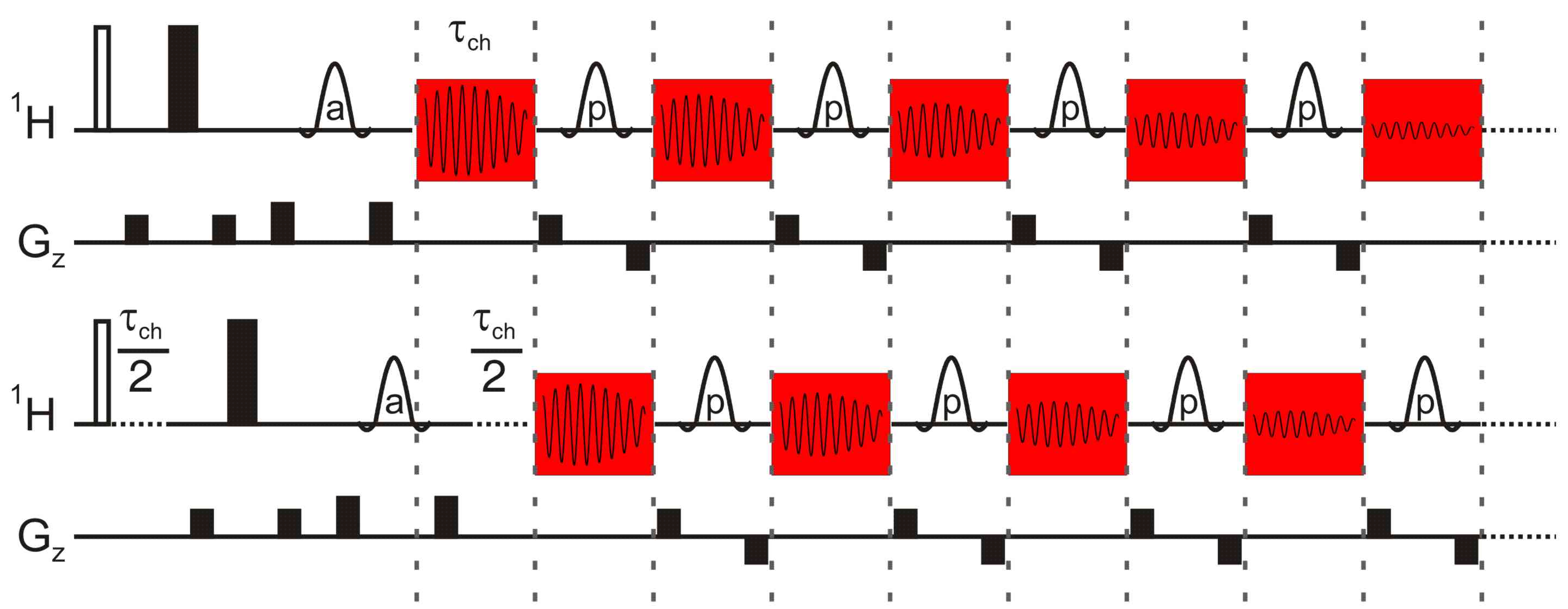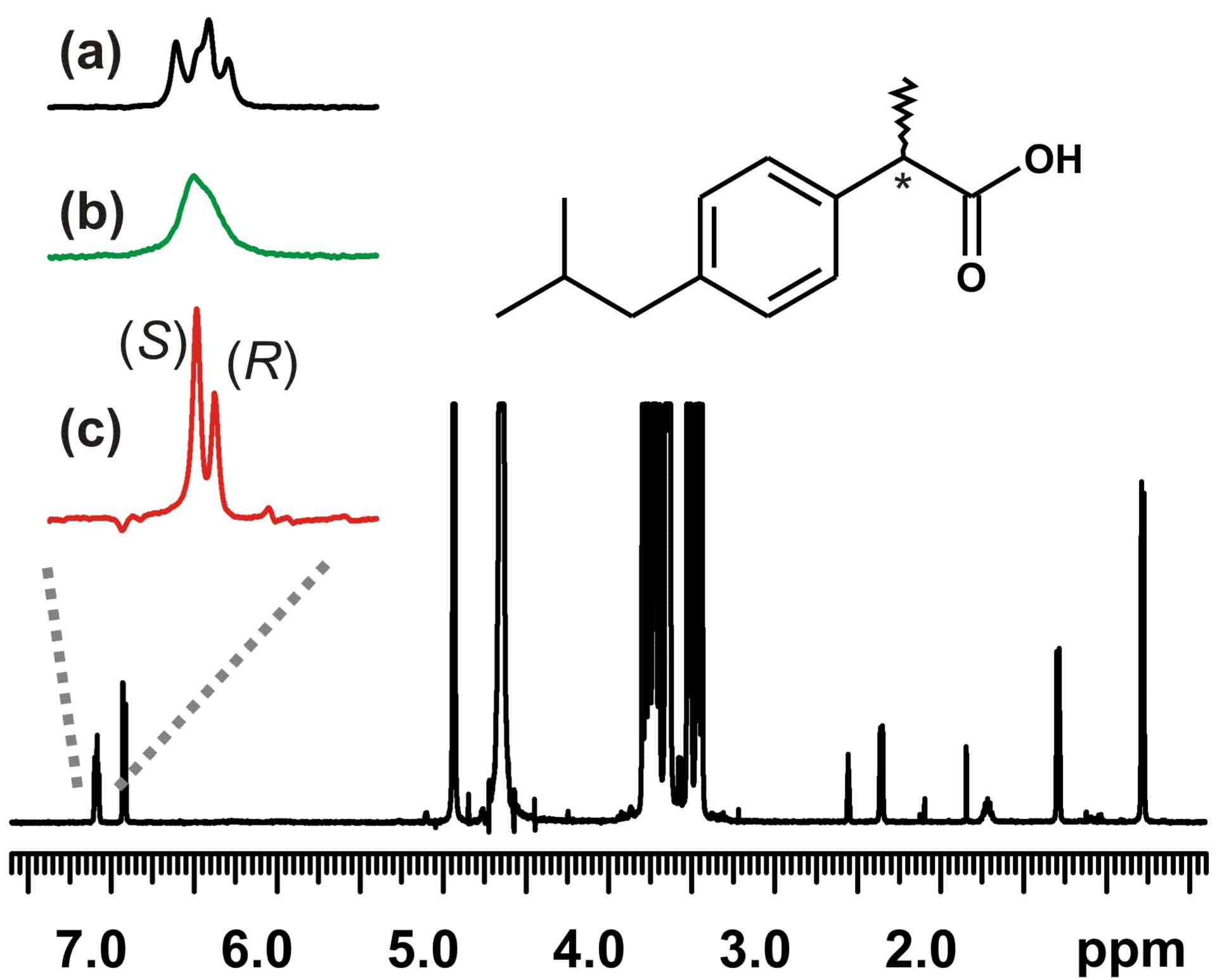- 1D PSYCHE
- 1D TSE-PSYCHE
- 1D Zangger-Sterk
- 1D Selective TOCSY-PSYCHE
- 1D SAPPHIRE
- 1D semi-real-time pure shift
- 2DJ-ZQS-PSYCHE
- 2D F1-PSYCHE-TOCSY
- 2D rtPS-gHSQC
- GEMSTONE
- GEMSTONE-CLIP-COSY
- GEMSTONE-NOESY
- GEMSTONE-ROESY
- GEMSTONE-TOCSY
- PSYCHE-iDOSY
- DOSY Oneshot
- Oneshot-iDISPEL
- 1D FESTA
- REST
- PUREST
- SCALPEL
- PROJECT
- DISPEL
- ODYSSEUS
- DOSY Oneshot (3ax)
- 3D Oneshot-HSQC
- 19F DOSY Oneshot45
- Pure Shift DOSY Oneshot
- 2D Constant-Time nQF-COSY
- PE WATERGATE (solvent suppression)
- 2D Zangger-Sterk NOESY
Semi-real-time pure shift NMR
Summary:
Pure Shift NMR Spectroscopy suppresses the effects of homonuclear coupling, allowing proton NMR spectra to be produced that contain chemical shifts only. Interferogram-style acquisition experiments (Zangger-Sterk, PSYCHE, TSE-PSYCHE, SAPPHIRE) can provide very good resolution enhancement, but their acquisition scheme increases the dimensionality of the parent experiment. Experiment times are typically around 20 times that of the parent experiment, but substantially longer if digital resolution comparable to that in routine conventional proton spectra is required. Real-time acquisition methods (e.g. PS-HSQC) allow faster experiments by interleaving J-refocusing and detection periods in a single acquisition. Unfortunately the price of speeding up the experiment is that resolution is lost: relaxation and pulse imperfections cause the signal to decrease in each successive J-refocusing element, broadening the pure shift lines and reducing the resolution advantage of the method.
Semi-real-time pure shift acquisition1 avoids this problem by allowing continued free precession of the active spins while passive spin inversion elements are applied, using complementary data acquisitions to ensure that a complete pure shift FID is sampled. In most cases two experiments, time shifted as in an interferogram method, provide all the data required, but if very selective passive spin inversion is essential then more experiments can be used.

In the example shown, a band-selective implementation, the selection of the chemical shift range to be observed (the active spins) is similar to that in other band-selective pure shift experiments. Two different kinds of passive spin inversion method (the soft pulses labelled “p†in the figure) were implemented. The first was a WATERGATE element in which only signals from the null excitation region are retained. In the final pure shift spectrum this results in a small broadening due to relaxation loss, similar to that in real-time experiments but substantially smaller, and with no contribution from pulse imperfections. The second employed a user-defined list of offsets and bandwidths to create a multi-frequency RSNOB pulse acting only on the passive spin regions. This requires knowledge of passive spin frequencies, but this is quick and easy to acquire with a scout experiment such as selective 1D COSY or TOCSY. The advantage of this kind of passive spin inversion is that extraneous broadening of the pure shift signal is completely avoided, so this method gives the same resolution as interferogram-style acquisition. Example spectra of 0.8 mM R- and 1.6 mM S-ibuprofen and 10 mM β-cyclodextrin in D2O, using (a) conventional proton, (b) real-time and (c) semi-real-time band-selective pure shift NMR, are shown below.

Downloads:
Varian / Agilent
Example data sets, setup macros and pulse sequence codes are provided here. Our experiments were acquired using a Varian/Agilent DDR system and VnmrJ 4.0 software. The pulse sequence code is not compatible with older consoles (Inova/Mercury) or VnmrJ versions before 4.0. We regret that we cannot support older versions of VnmrJ for data acquisition.
Pulse sequence code: .c file (copy to ~/vnmrsys/psglib/.)
Macro files: .zip file (extract and copy to ~/vnmrsys/maclib/.)
Example data set: all.zip file or example.zip file (extract and copy .fid directories to any data directory)
Bruker
Compatibility: TopSpin-4, Neo, Linux or Windows PC
Example data, pulse programs, parameter sets, and macros: .zip file (extract and copy to relevant directories e.g. $TSHOME/exp/stan/nmr/list/pp/user/kp_srtACQn_r1). This pulse program is not compatible with older Avance-3/2 console and TopSpin 3.
A pdf manual is available here.
References:
1 Semi-real-time acquisition for fast pure shift NMR at maximum resolution
Kiraly, P.; Nilsson, M.; Morris, G. A.
J. Magn. Reson. 2018, 293, 19-27
